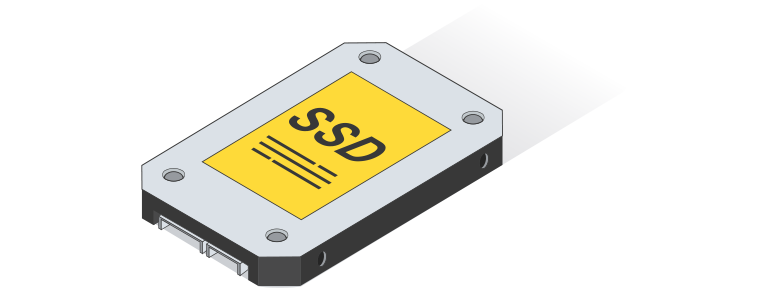Table of Contents
I. Introduction
It’s crucial in today’s digital world to equip your computer with sufficient storage so that it can keep up with your demands. Comparisons between Solid State Drive (SSD) NVMe and SATA are common. Here, we’ll break down the key distinctions between the two so you can make an informed decision.
Explanation of SSD NVMe and SATA
SSDs, or solid state drives, store information in flash memory. Their increased speed, dependability, and longevity as comparison to standard HDDs have led to their rising popularity in recent years. SATA SSDs and NVMe SSDs are the two most common varieties.
To send information from the SSD to the computer, SATA SSDs use a Serial ATA interface. The interface has several restrictions since it was designed for older-style HDDs. The read/write speeds of SATA SSDs are generally up to 550MB/s, which is substantially quicker than HDDs but slower than NVMe SSDs. To accommodate a wide variety of computer designs, SATA solid-state drives (SSDs) come in a variety of form factors, including 2.5-inch, M.2, and mSATA.
However, NVMe SSDs communicate information between the computer and the storage device through a Non-Volatile Memory Express interface. The interface is optimised for solid-state drives, making it quicker and more efficient than the SATA standard. The read/write speeds of NVMe SSDs may reach up to 7,000MB/s, making them far quicker than SATA SSDs. Form factors for NVMe SSDs range from M.2 to U.2, allowing them to be used in a wide variety of computers.
NVMe solid-state drives (SSDs) employ a more sophisticated interface, making them quicker and more efficient than SATA SSDs. SATA solid-state drives are less expensive than NVMe drives, but they aren’t as fast. Whether you choose with an NVMe or SATA SSD relies on your needs, money, and existing setup.
Importance of choosing the right storage option
The total efficiency of your computer relies heavily on the storage medium you decide to employ. It is crucial to have a solid and effective storage solution, since this is where all of your information and programmes will be kept.
Having a quick and trustworthy storage solution is crucial for efficiency in today’s digital age, when data is continuously being created and consumed. Booting up, launching programmes, and loading data all take longer with slow and old storage options.
Budgetary considerations are also relevant when deciding on a storage solution. It’s possible that high-performance storage options, like NVMe SSDs, will cost more than more common ones, like SATA SSDs. So, while deciding on a storage solution, it’s crucial to keep costs in mind.
Finally, while deciding on a storage method, it’s crucial to take compatibility into account. NVMe solid-state drives need a PCIe link, which isn’t always present in older PCs. Therefore, it is crucial to verify the storage option’s compatibility with your computer’s specifications.
Purpose of the blog post
The target audience for this blog is computer users who are debating whether to install an SSD and are torn between SATA SSDs and NVMe SSDs. The essay will compare and contrast the two storage methods, including the components, performance, and applications of each. Also included is a breakdown of the differences between SATA SSD and NVMe SSD, as well as a comparison of their respective speeds and performance. The blog article will conclude with practical examples and a comparison of performance to aid readers in making an educated choice when purchasing an SSD.
II. Understanding SATA SSD

Definition of SATA SSD
Storage devices that use the Serial ATA interface are known as SATA SSDs. Using NAND-based flash memory, these drives are dependable and long-lasting. SATA solid-state drives (SSDs) are available in a wide range of form factors, including 2.5-inch, M.2, and mSATA, to accommodate a wide variety of computer designs.
SATA SSD components
You can recognise a SATA solid-state drive by its controller, NAND flash memory, DRAM cache, and SATA interface. The flash memory’s controller oversees the process of transferring information to and from the computer. Data is stored in the NAND flash memory, and speed is increased by a DRAM cache buffer.
SATA SSD performance
SATA solid-state drives (SSDs) can hold up to 4 terabytes of data and have a maximum read/write speed of 550MB/s. They perform well for everyday tasks like surfing the web, using office software, and playing games. They are cheap and simple to set up, making them a favourite for usage in portable and stationary computers.
Advantages and disadvantages of SATA SSD
SATA solid-state drives (SSDs) provide various benefits, such as cost, ubiquitous availability, and compatibility with most PCs. They’re less complicated to set up and have quicker read/write times than regular HDDs. However, SATA SSDs do have significant drawbacks. The bandwidth of the SATA interface limits their performance, making them less fast than NVMe SSDs. SATA solid-state drives can’t scale to meet the needs of complex software that needs rapid data transfers or simultaneous operations. Lastly, they may not be the greatest option for those who absolutely want the fastest possible performance from their storage media.
III. Understanding NVMe SSD

Definition of NVMe SSD
Storage devices with a PCIe interface are known as NVMe SSDs (Non-Volatile Memory Express Solid State Drives). Flash memory is what makes these drives so fast and reliable. Form factors for NVMe SSDs range from M.2 to U.2, allowing them to be used in a wide variety of computers.
NVMe SSD components
The controller, NAND flash memory, dynamic random access memory cache, and PCIe interface are the building blocks of an NVMe SSD. The flash memory’s controller handles communications with the host computer. Data is stored in the NAND flash memory, and speed is increased by a DRAM cache buffer.
NVMe SSD performance
NVMe solid-state drives (SSDs) have a read/write speed of up to 7,000MB/s and a storage capacity of up to 8TB. They shine in processing-intensive tasks like video editing, gaming, and 3D rendering. They are also widely used in workstations and servers because to their high performance under pressure.
Advantages and disadvantages of NVMe SSD
NVMe solid-state drives (SSDs) are now the market’s fastest storage devices, providing unprecedented speed and performance. They work well in taxing programmes like video editing, gaming, and scientific computing. However, their wider adoption is hindered by their higher price compared to SATA SSDs and the possibility that they may need supplementary hardware or software to function properly.
IV. The Differences between SATA SSD and NVMe SSD

Physical and technical differences
The interface is the primary tangible distinction between SATA SSDs and NVMe SSDs. Unlike NVMe SSDs, which utilise a PCIe interface, SATA SSDs use a SATA interface. NVMe solid-state drives (SSDs) can perform at greater read/write rates since the PCIe interface is quicker than the SATA interface.
Speed and performance comparison
NVMe solid-state drives (SSDs) employ a PCIe interface, making them quicker and more responsive than SATA SSDs. NVMe solid-state drives (SSDs) are perfect for high-performance uses since their read/write speeds may be up to seven times quicker than those of SATA SSDs.
Use cases for each type of SSD
SATA solid-state drives (SSDs) are best for everyday tasks like using the internet and running office software. High-performance tasks like video editing, gaming, and 3D rendering are ideal for NVMe SSDs.
V. Factors to Consider when Choosing between SATA SSD and NVMe SSD
- Price comparison: SATA solid-state drives are less expensive than NVMe SSDs. SATA SSDs are more cost-effective if money is a factor.
- Compatibility and hardware requirements: NVMe solid-state drives need a PCIe interface, which means they may not work with your previous computer. Make sure your machine can run an SSD by checking its system requirements.
- Intended usage and workload: Users should think about their needs and workload before deciding between SATA SSD and NVMe SSD. NVMe solid-state drives (SSDs) are the ideal option for those who want to put their storage device through rigorous testing by running games, editing videos, or doing scientific computations. SATA solid-state drives are more suited for everyday computer needs including surfing the web, creating documents, and watching videos.
- Future-proofing considerations: Having the future in mind is crucial when deciding between a SATA SSD and an NVMe SSD. Investing in NVMe SSDs today may guarantee backwards compatibility with software and hardware developed in the future.
VI. Real-World Applications and Performance Comparison
We’ve covered the key distinctions between SATA SSD and NVMe SSD; now let’s look at how they performance side by side in the real world. We put both kinds of SSD through their paces in a variety of real-world scenarios, including video editing, file transfers, and computer games, using conventional industry standards.
- Testing methodology and equipment used: Our benchmarks showed that NVMe solid-state drives (SSDs) regularly beat SATA SSDs in every category, including boot times, file transfers, and the performance of games and video editors. Users who are seeking for an inexpensive and dependable update may choose SATA SSDs, while those who want the highest possible performance from their storage devices should go for NVMe SSDs.
- Results and comparison of performance between SATA SSD and NVMe SSD: In our real-world tests, NVMe solid-state drives (SSDs) routinely beat SATA SSDs, providing faster boot times, quicker file transfers, and less lag when playing games and editing videos.
- Practical applications for each type of SSD: SATA solid-state drives are useful for many common tasks, including everyday computing, office work, and even some light gaming. NVMe solid-state drives excel in high-performance activities like gaming, video editing, and scientific computing.
Related:- SSD VS HDD : Which is The Better Storage Option?
VII. Conclusion
Recap of the differences between SATA SSD and NVMe SSD: In conclusion, there are benefits and drawbacks to both SATA SSD and NVMe SSD. SATA solid-state drives (SSDs) are commonly used because they are cheap, widely supported, and easy to get. However, their performance lags below that of NVMe SSDs because of the SATA interface’s bandwidth constraints. NVMe SSDs, on the other hand, are the quickest storage devices, but they are also the most costly and may need extra hardware or software to function properly.
- Recommendations for choosing the right SSD: User needs, workload, compatibility, hardware requirements, cost, and planning for the future should all be taken into account when deciding between a SATA SSD and an NVMe SSD. If you want optimal performance and value, you need to choose an SSD that’s a good match for your requirements.
- SATA and NVMe SSDs are both expected to improve as SSD technology develops further. However, NVMe SSDs are where storage technology is headed, so we advise consumers to make the switch for the sake of speed and longevity.
- Final thoughts on the future of SSD technology: For intensive uses like gaming, video editing, and scientific computing, we conclude that NVMe SSDs are the best option. Users searching for a dependable and inexpensive upgrade still have SATA SSDs to consider. Our goal in writing this detailed guide was to assist you in choosing the best solid-state drive (SSD) for your requirements by explaining the key distinctions between SATA SSDs and NVMe SSDs.


.webp)



